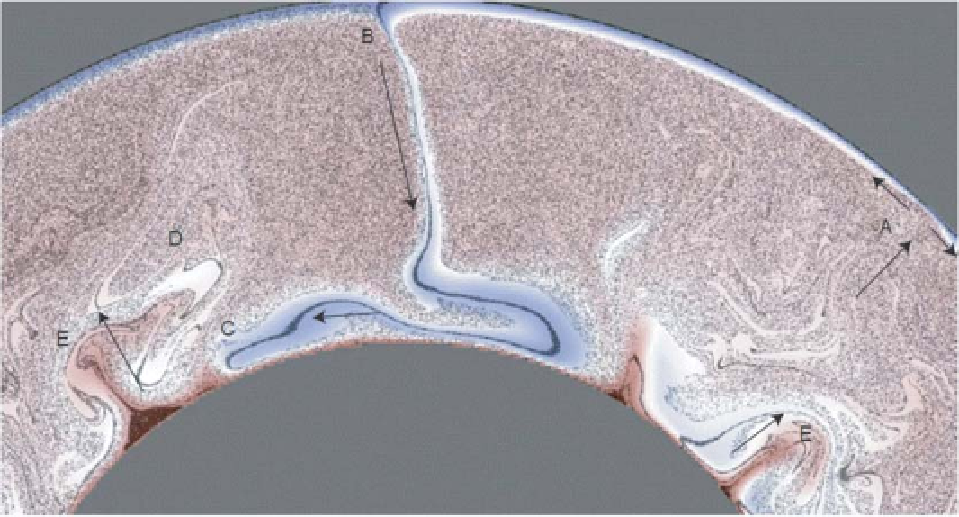Geoscience Reference
In-Depth Information
Fig. 12.1
A snapshot of a thermochemical model that illustrates the role of oceanic crust formation and mixing
(reproduced from Plank & van Keken, 2008). At the mid-oceanic ridge (A) the oceanic crust is formed (black). The
white layer below this is the harzburgite from which the basalt has been extracted. At the subduction zone (B) we
extract elements to gradually build up the continental crust. The heterogeneity is retained upon subduction but
sequestration of the crust occurs at the base of the mantle (C) which can then be brought back up in plumes (E) or
be mixed back into the mantle (D).
investigated how the formation of oceanic crust
and continental crust extraction affects the chem-
ical evolution of the Earth's mantle. Figure 12.1
illustrates the model.
The modeling assumptions are detailed in Bran-
denburg
et al
., 2008. In brief, we model thermo-
chemical convection in a 2D cylindrical geometry
using high-resolution finite element methods.
We use a method to simulate tectonic plates in
which we prescribe the geometry of the plates
but determine the velocity of the plates from
the convective stresses. This approach creates
platelike motions without violating the energy
balance. The models run for 4.5 Byr at Earth-
like convective vigor, as measured by the surface
heat flow and plate velocities. The rheology is a
simplified temperature- and pressure dependent
rheology. The lower mantle is 30x more viscous
on average than the upper mantle. We do not
take into account any rheological effects of water,
grain-size of composition. The models start with
a uniform peridotite composition and we extract
oceanic crust (leaving a harzburgite residue) at
the mid-oceanic ridges, which are the regions
where plates move apart. We follow the geo-
chemical evolution of the tracers in the U-Th-Pb,
Rb-Sr, Re-Os, and Sm-Nd systems where we as-
sume fractional melting at the ridges. We extract
continental crust at convergent plate boundaries.
The higher density of the oceanic crust at depth
causes a pooling of oceanic crust at the bot-
tom of the mantle. From a statistical sampling
of the geochemistry of the tracers in the man-
tle we can determine whether the geochemical
modeling satisfies the observational constraints.
Most importantly, these models allow us to test
whether oceanic crust formation and recycling,
along with continental crust extraction, can re-
produce the observed heterogeneity in the various
isotope systems.

